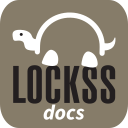LOCKSS 1.x to 2.x Migration Guide#
Warning
This page is under construction. LOCKSS 1.78 and LOCKSS 2.0-beta1 have not yet been released.
Welcome, LOCKSS 1.x users!
This document will guide you as you install LOCKSS 2.x and migrate the data you preserve in LOCKSS 1.x to LOCKSS 2.x.
You have the option to install LOCKSS 2.x on a brand-new physical or virtual machine (recommended), or to install it on the same machine as LOCKSS 1.x.
Tip
Why is a new machine recommended?
Running LOCKSS 1.x and LOCKSS 2.x together on the same machine will significantly degrade performance and cause the migration process to take much longer.
Unlike LOCKSS 1.x, LOCKSS 2.x can be installed on a great variety of operating systems. This is an opportunity to move to a new machine better fitting your institution's IT infrastructure preferences.
Overview of the Migration#
The migration process has three major phases:
Preparing your LOCKSS 2.x machine.
If you are installing LOCKSS 2.x on a new machine (recommended), you will need to commission a new Linux host.
If you are installing LOCKSS 2.x on a LOCKSS 1.x machine, you will need to ensure that the machine meets the requirements for LOCKSS 2.x, and if necessary to upgrade the operating system.
Installing and configuring LOCKSS 2.0-beta1.
Configuring and running the migration process in the LOCKSS 1.x Web user interface.
Frequently Asked Questions about the Migration#
FIXME -- IGNORE ALL THIS BELOW:
Prepare your LOCKSS 2.x machine.
Select the scenario that fits your situation:
You will need to commission a new Linux host. See the LOCKSS 2.0-beta1 System Prerequisites page.
For historical reasons, many LOCKSS 1.x machines are currently running RHEL 7 compatible operating systems like CentOS 7, which have reached end of life. Before co-installing LOCKSS 2.x with LOCKSS 1.x, you must upgrade your RHEL 7 compatible system like CentOS 7 to a RHEL 9 compatible operating system like Rocky Linux 9.
CentOS 7 to Rocky Linux 9 (recommended): See Alma ELevate in the LOCKSS Community Wiki. This upgrade path uses the Alma ELevate tool.
CentOS 8.5 or CentOS Stream to Rocky Linux 9: See How to migrate to Rocky Linux from CentOS Stream, CentOS, AlmaLinux, RHEL, or Oracle Linux in the Rocky Linux Documentation. This upgrade path uses the
migrate2rockytool.CentOS 8.4 to AlmaLinux OS 9: See AlmaLinux Migration Guide in the AlmaLinux Wiki. This upgrade path uses the
almalinux-deploytool.RHEL 7 to RHEL 9: See Upgrading from RHEL 7 to RHEL 8 and Upgrading from RHEL 8 to RHEL 9 in the Red Hat Customer Portal. This upgrade path uses the Leapp tool.
CentOS 7 or CentOS 8 or CentOS Stream to Oracle Linux 9: See Switch From CentOS Linux to Oracle Linux in the Oracle Help Center. This upgrade path uses the
centos2oltool.
